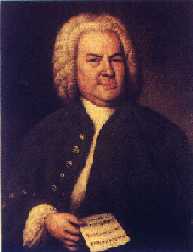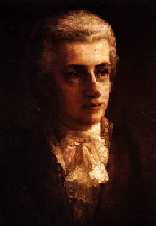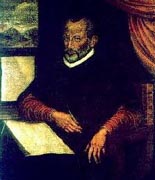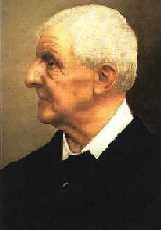

|
|
| Musical Musings: Composers |
Great Music — Absolutely!by Gary D. Penkala
When a spacecraft named Voyager neared a remote world it greeted the inhabitants thereof — if any — with the music of the first movement of Bach's Brandenburg Concerto No.2 in F. Actually there were two such spacecraft, Voyager I and Voyager II, launched in 1977 on a course that would take them through the solar system and beyond, to the realm of the stars. Among the devices with which each was equipped was a gold-coated phonograph record containing an hour and a half of music, in addition to spoken greetings. The music included three pieces by Bach: the first movement of the Brandenburg Concerto No.2 in F (which opened the record), the Prelude and Fugue in C from Book II of The Well-Tempered clavier, and the Gavotte en Rondeau from Partita No.3 for Unaccompanied Violin. The Brandeburg concerto was chosen as the first music from earth to be heard because of its feeling of "energetic optimism." 
Even in the scientific community, among those interested in trajectories and orbits rather than trumpets and oboes, there is agreement as to what is "great" music. Music that has lasted, music that has inherent "absolute" value, was chosen as representing the finest mankind has to offer in the area of auditory art. While each of the scientists had his own taste and personal informal listening favorites (including Carl Sagan and Lewis Thomas), the concensus among them, when asked to represent Planet Earth before the Extra-terrestrial Life Form, was to choose great music — Bach, Mozart, Beethoven. How interesting! For E.T. we choose the Masters, yet for Almighty God, some ditty sounding like it was slopped off in a nightclub on a cocktail napkin will suffice. The state of Catholic church music at the end of the 20th century was abysmal. We had been lured into erroneous thinking by relativism, just as it infected moral thought. What is "good," whether referring to moral and ethical practices or worthy and noble music, depended on numerous factors, each relative to the perpetrator or the listener. We justified greed ... "in this situation." We tolerated lies as ... "misinformation." We accepted killing if ... "it was in the mother's best interest." And, we promoted tawdry music because ... "it made people happy." The 21st century has brought a revolution in liturgical music. No longer is the measuring stick to be human emotion ... "warm-fuzzy" music is going the way of asbestos and saccharine, although it may take quite a while to rid our systems of lingering residues. Sandro Magister writes: Now there is a pope, Benedict XVI, who is highly competent in the area of sacred music, is severely critical of the degradation of music following the council, and has written on a number of occasions what he thinks and what he wants: to restore to the Catholic liturgy the great music that "from Gregorian chant passes through the music of the cathedrals and polyphony, the music of the Renaissance and the Baroque, to Bruckner and beyond." So who are the "greats" in Catholic church music? Here are a few:
Giovanni Pierluigi da Palestrina (1525-1594)Perhaps most important in the continuity of traditional Catholic music is Renaissance composer, Giovanni Pierluigi da Palestrina, whose brilliant career in Rome gained him the title "Savior of Church Music." He spent most of his adult life working in Rome, first as choirmaster at Saint Peter's Basilica, then at Saint John Lateran and Saint Mary Major, before returning to work at Saint Peter's under Pope Julius III (the former bishop of the town of Palestrina where the musician was born). His compositional output was almost entirely vocal, the vast majority of that, sacred. He wrote 104 masses, 68 offertories, 250 motets, 45 hymns, psalms, 33 magnificats, litanies, 4 or 5 sets of lamentations . He is credited with a spiritual reform of liturgical music, helping to purge secular influences and return church music to a holy and inspirational state. Oh, the parallels to today!
Wolfgang Amadeus Mozart (1756-1791) Mozart, an Austrian child prodigy of the 18th century, was born into a Catholic family and baptized Johannes Chrysostomus Wolfgangus Theophilus Mozart on January 28, 1756, the day after he was born.
He extensively toured Europe as a child performer on harpsichord and pianoforte.
While in Rome, Mozart amazed those around him (including his father, Leopold, and Pope Clement XIV) with his musical talents:
Mozart, an Austrian child prodigy of the 18th century, was born into a Catholic family and baptized Johannes Chrysostomus Wolfgangus Theophilus Mozart on January 28, 1756, the day after he was born.
He extensively toured Europe as a child performer on harpsichord and pianoforte.
While in Rome, Mozart amazed those around him (including his father, Leopold, and Pope Clement XIV) with his musical talents:
It was custom during Holy Week in the Sistine Chapel to sing the exceptionally beautiful piece of music known as the Miserere, written a century earlier by Gregorio Allegri. The work, performed by two choirs of nine voices, was exclusive to the Sistine Chapel and could not be published, but was handed down from choirmaster to choirmaster.Having returned to Austria, Mozart took a position as music director for the Prince-Archbishop of Salzburg. Many of his sacred compositions were written for performance there in the cathedral dedicated to Saint Rupert and Saint Virgil, including many works called Missa brevis ("Short Mass") which lacked a Credo movement and satisfied the archbishop's preference for brief music. While noted mainly for his instrumental compositions and his operas, Mozart also wrote fifteen Masses, litanies, offertories, his great Requiem, as well as many smaller motets, most of them written for soli, chorus, and orchestra. Perhaps most famous is his setting of "Ave verum" for SATB choir and strings.
Anton Bruckner (1824-1896)John W. Ehrlich writes:Anton Bruckner, known best for his vast symphonic canvases, was very much a product of the Austro-German tradition and felt the power of Roman Catholicism early in his life, and remained a fervent believer throughout it. Indeed, his earliest musical experiences were church services in an Augustinian monastery, and his early performing experiences were as a choir director.And there you have three great composers for the Church, from vastly different eras, but each, who in reflecting on his music, saw it not as blazing new trails, but falling squarely in the tradition of what had gone before. And that is a mark of "good" church music! |

